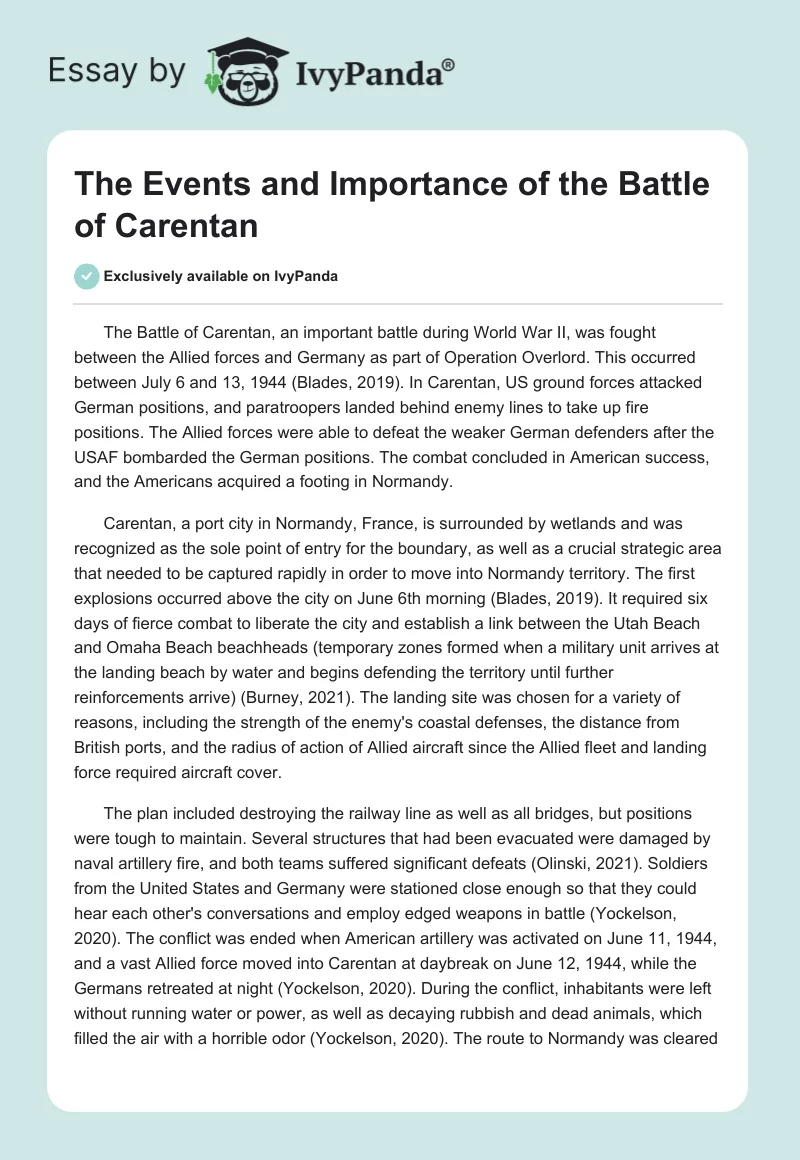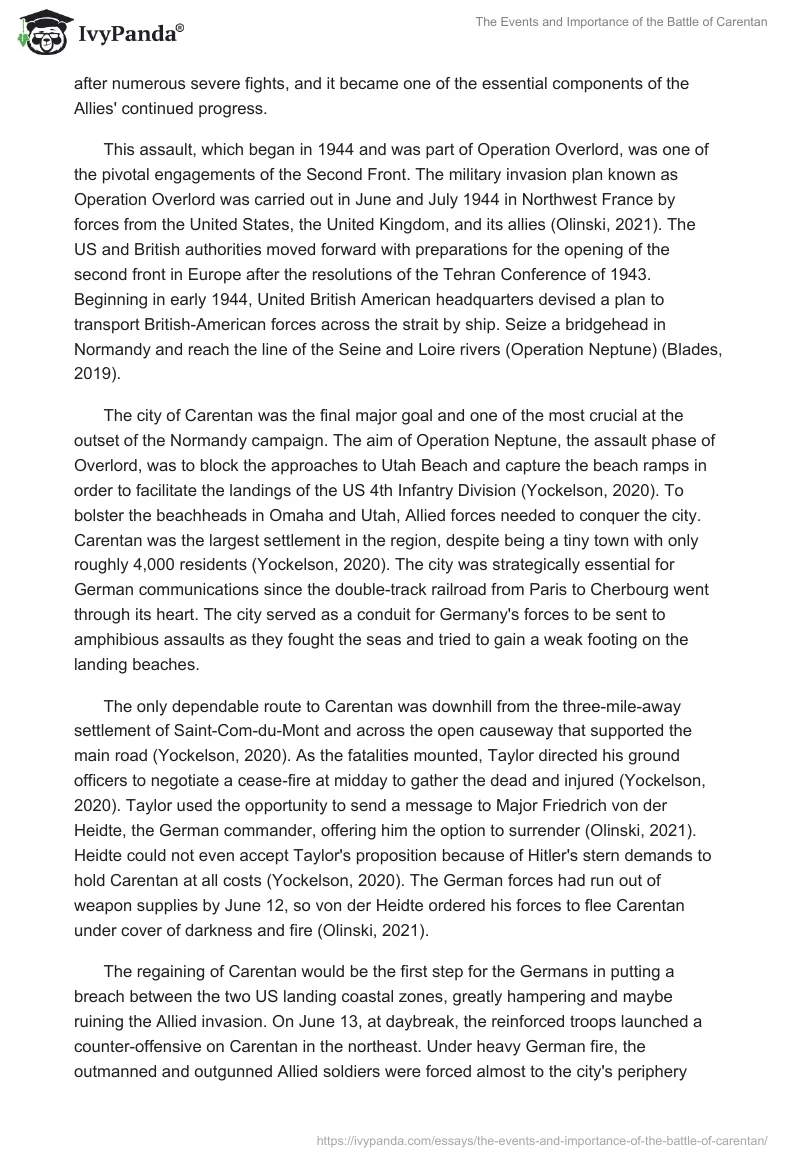The Battle of Carentan, an important battle during World War II, was fought between the Allied forces and Germany as part of Operation Overlord. This occurred between July 6 and 13, 1944 (Blades, 2019). In Carentan, US ground forces attacked German positions, and paratroopers landed behind enemy lines to take up fire positions. The Allied forces were able to defeat the weaker German defenders after the USAF bombarded the German positions. The combat concluded in American success, and the Americans acquired a footing in Normandy.
Carentan, a port city in Normandy, France, is surrounded by wetlands and was recognized as the sole point of entry for the boundary, as well as a crucial strategic area that needed to be captured rapidly in order to move into Normandy territory. The first explosions occurred above the city on June 6th morning (Blades, 2019). It required six days of fierce combat to liberate the city and establish a link between the Utah Beach and Omaha Beach beachheads (temporary zones formed when a military unit arrives at the landing beach by water and begins defending the territory until further reinforcements arrive) (Burney, 2021). The landing site was chosen for a variety of reasons, including the strength of the enemy’s coastal defenses, the distance from British ports, and the radius of action of Allied aircraft since the Allied fleet and landing force required aircraft cover.
The plan included destroying the railway line as well as all bridges, but positions were tough to maintain. Several structures that had been evacuated were damaged by naval artillery fire, and both teams suffered significant defeats (Olinski, 2021). Soldiers from the United States and Germany were stationed close enough so that they could hear each other’s conversations and employ edged weapons in battle (Yockelson, 2020). The conflict was ended when American artillery was activated on June 11, 1944, and a vast Allied force moved into Carentan at daybreak on June 12, 1944, while the Germans retreated at night (Yockelson, 2020). During the conflict, inhabitants were left without running water or power, as well as decaying rubbish and dead animals, which filled the air with a horrible odor (Yockelson, 2020). The route to Normandy was cleared after numerous severe fights, and it became one of the essential components of the Allies’ continued progress.
This assault, which began in 1944 and was part of Operation Overlord, was one of the pivotal engagements of the Second Front. The military invasion plan known as Operation Overlord was carried out in June and July 1944 in Northwest France by forces from the United States, the United Kingdom, and its allies (Olinski, 2021). The US and British authorities moved forward with preparations for the opening of the second front in Europe after the resolutions of the Tehran Conference of 1943. Beginning in early 1944, United British American headquarters devised a plan to transport British-American forces across the strait by ship. Seize a bridgehead in Normandy and reach the line of the Seine and Loire rivers (Operation Neptune) (Blades, 2019).
The city of Carentan was the final major goal and one of the most crucial at the outset of the Normandy campaign. The aim of Operation Neptune, the assault phase of Overlord, was to block the approaches to Utah Beach and capture the beach ramps in order to facilitate the landings of the US 4th Infantry Division (Yockelson, 2020). To bolster the beachheads in Omaha and Utah, Allied forces needed to conquer the city. Carentan was the largest settlement in the region, despite being a tiny town with only roughly 4,000 residents (Yockelson, 2020). The city was strategically essential for German communications since the double-track railroad from Paris to Cherbourg went through its heart. The city served as a conduit for Germany’s forces to be sent to amphibious assaults as they fought the seas and tried to gain a weak footing on the landing beaches.
The only dependable route to Carentan was downhill from the three-mile-away settlement of Saint-Com-du-Mont and across the open causeway that supported the main road (Yockelson, 2020). As the fatalities mounted, Taylor directed his ground officers to negotiate a cease-fire at midday to gather the dead and injured (Yockelson, 2020). Taylor used the opportunity to send a message to Major Friedrich von der Heidte, the German commander, offering him the option to surrender (Olinski, 2021). Heidte could not even accept Taylor’s proposition because of Hitler’s stern demands to hold Carentan at all costs (Yockelson, 2020). The German forces had run out of weapon supplies by June 12, so von der Heidte ordered his forces to flee Carentan under cover of darkness and fire (Olinski, 2021).
The regaining of Carentan would be the first step for the Germans in putting a breach between the two US landing coastal zones, greatly hampering and maybe ruining the Allied invasion. On June 13, at daybreak, the reinforced troops launched a counter-offensive on Carentan in the northeast. Under heavy German fire, the outmanned and outgunned Allied soldiers were forced almost to the city’s periphery (Yockelson, 2020). The tanks counterattacked southwest of Carentan, escorted by infantry, inflicting huge losses on the Germans and forcing them to flee at this vital stage (Burney, 2021). Following the American triumph, soldiers from Utah and Omaha beaches were combined to form a secure staging location for future American operations.
The Normandy Amphibious Operation, another name for Operation Overlord, became the largest amphibious operation of the 2nd World War and opened a second front in Europe, which became an essential factor in the successful conduct of warfare actions by the countries of the anti-Hitler coalition at the final stage of the war against Germany. At the outset of the war, Allied leaders Franklin D. Roosevelt and Winston Churchill believed that a major invasion of continental Europe would be necessary to relieve pressure from the Soviet army fighting the Nazis in the east (Blades, 2019). Roosevelt and Churchill intended to assault Europe through Italy after invading North Africa. The Normandy campaign became the most ambitious military strategy ever devised.
The Allied assault in Normandy in August 1944 brought the whole German Western Front to a halt, and German soldiers were only able to re-establish a new front line on Germany’s western border in September 1944, known as the “Siegfried Line” (Blades, 2019). The Allies approached Germany’s western border over its entire length in the fall of 1944 and, in some areas, even crossed it. In November 1944, American and French soldiers began an attack across the Vosges Mountains in north-eastern France, liberating much of Alsace and Lorraine and reaching the Upper Rhine in Alsace (Blades, 2019). As a result, Germany has lost nearly all of its Western European positions.
Hundreds of thousands of American, Canadian, and European troops fought at the Battle of Carentan as part of the biggest invading force in history. The invasion of Europe from the north of France in 1944 was the Western Allies’ greatest major success in World War II. After a long and expensive fight to secure their victories on the Normandy beaches, American, British, and Canadian forces stormed into the interior of France and began a quick onslaught (Blades, 2019). Despite heavy German opposition, particularly on Omaha Beach, the Americans, British, and Canadians held the defense and provided a crucial springboard for the liberation struggle.
In terms of strategy, Germany was on the verge of defeat at this point in the conflict. The Wehrmacht was beaten in the east and forced to retire, having been overwhelmed by Russian forces and the weather; German towns were decimated by incessant Allied bombing, and the Luftwaffe was reduced to a few small pockets of resistance (Blades, 2019). In France, what little German military force left was significant but not enough to prevent defeat for long. Normandy, on the other hand, was not a sideshow. Regardless, the Allies’ successful landing signaled America’s emergence as the world’s preeminent force.
The Allies might regroup and try again if the D-Day landings failed. The continental United States was mostly unaffected by the war’s effects. However, a second effort at D-Day, which failed in 1944, may have resulted in the employment of nuclear weapons (Blades, 2019). Meanwhile, Eurasia has arguably come under the rule of another great authoritarian power, the Iron Curtain, which has drawn considerably closer to the English Channel than Germany’s internal boundary.
The days of German resistance were numbered after the success of Operation Overlord. As the Allies made their way east, Paris was secured in August 1944 (Blades, 2019). In the meantime, the Soviet Union was encroaching on German territory. The Normandy campaign, particularly the Battle of Carentan, was a grueling battle. On the eastern side of the front, British forces took the main weight of German resistance, allowing American soldiers to achieve a breakthrough in the west (Blades, 2021). The infantry, in particular, suffered a lot of casualties (Blades, 2019). Because the Allied drive towards the German border could not be sustained, the Germans were able to reorganize. Moreover, the campaign came to a standstill as winter approached.
In December, Hitler’s final desperate counter-offensive in the Ardennes failed to avoid defeat. The unexpected counter-offensive had considerable success at first but was quickly quelled by American forces. As the weather improved, Allied air strikes finished the job of destroying the German forces. The Allies began their offensive in March 1945, crossing the Rhine, Germany’s final major impediment, where the final crucial battle of the war happened on March 23, 1945 (Blades, 2019). Although there were many casualties, American forces had already crossed the river in several locations to the south, where, on the Elbe in April, British and American forces joined the Russians (Olinski, 2021). On May 7, 1945, Germany surrendered, bringing the war in Europe to a close.
Despite the heavy losses suffered by the Allied forces, the battle of Carentan was beneficial in terms of securing the base for the next advances of the army into the continent. It was the battle of Carentan that significantly impacted the whole Normandy campaign. Perhaps, if this battle would not have been won, the Allied forces would never make it into Europe, thus completely altering the course of the war.
References
Burney, R. E. (2021). D-Day to December 1944: The odyssey of the third auxiliary surgical group in World War II. Journal of Trauma and Acute Care Surgery, 91(2), S9-S18.
Blades, B. S. (2019). The Americans on D-Day & in Normandy. Pen and Sword.
Olinski, T. (2021). Timothy Heck, and BA Friedman (eds.), On Contested Shores: The Evolving Role of Amphibious Operations in the History of Warfare. Quantico: Marine Corps University Press, 2020. Journal of Military and Strategic Studies, 21(1).
Yockelson, M. (2020). Forgotten Fights: The 101st Airborne at Carentan. The National WWII Museum. Web.


